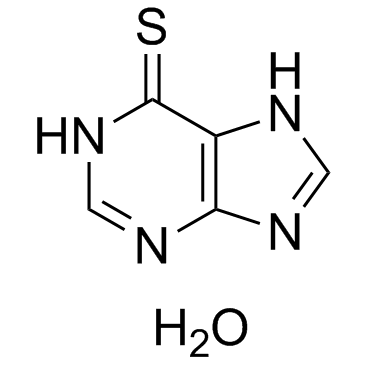6112-76-1
| Name | mercaptopurine hydrate |
|---|---|
| Synonyms |
9H-purine-6-thiol, hydrate (1:1)
7H-purine-6-thiol, hydrate (1:1) LEUKERIN MONOHYDRATE 6-Mercaptopurine monohydrate 6H-Purine-6-thione, 3,7-dihydro-, hydrate (1:1) 9H-Purine-6-thiol hydrate (1:1) 6MP H2O MERCALEUKIN MONOHYDRATE purin-6-thiol,monohydrate 1,7-Dihydro-6H-purine-6-thione hydrate (1:1) 6MP MONOHYDRATE EINECS 212-968-3 MFCD03854445 7H-purine-6-thiol hydrate 6-Mercaptopurine hydrate |
| Description | 6-Mercaptopurine hydrate is a purine analogue which acts as an antagonist of the endogenous purines and has been widely used as antileukemic agent and immunosuppressive drug. |
|---|---|
| Related Catalog | |
| Target |
endogenous purines[1] |
| In Vitro | 6-Mercaptopurine hydrate (6-MP) induces NR4A3 transcriptional activity 1.6- to 11-fold (P<0.01) in a dose-responsive manner. It is found that 6-Mercaptopurine hydrate leads to a dose-dependent increase in NR4A3 protein levels. 6-Mercaptopurine hydrate treatment increases cell surface GLUT4 in both basal cells 1.8- to 3.6-fold (P<0.01) and insulin-stimulated cells 2.9- to 4.4-fold (P<0.01) over that in controls. It is also found that 6-Mercaptopurine hydrate increases phospho-AS160 significantly in a dose-responsive manner under both basal and insulin-stimulated conditions[2]. |
| In Vivo | In the fetal telencephalons of the 6-Mercaptopurine hydrate (6-MP)-treated group, the S phase cell population increases at 36 and 48 h and returns to the control level at 72 h after treatment. The G2/M phase cell population begins to increase at 24 h, peaks at 36 h, decreases at 48 h, and finally returnes to the control level at 72 h. On the other hand, the sub-G1 phase cell population (apoptotic cells) begins to increase at 36 h, peaks at 48 h, and then decreases at 72 h[3]. |
| Kinase Assay | L6 myotubes are treated with DMSO control or 6-Mercaptopurine hydrate (6-MP) for 24 h, with the final 3 h of incubation including treatments in serum-free DMEM, and further incubated in the absence or presence of 100 nM insulin for 60 min at 37°C. Then, protein lysates (50 μg) are collected and subjected to SDS-PAGE. The proteins are finally quantified by densitometric analysis of scanned films using Image J software[2]. |
| Cell Assay | Cell viability is measured using Cell Viability Assay. L6 skeletal muscle cells are seeded in 96-well plates at a density of 10,000 cells/well and differentiated into myotubes within 7 days. Cells are treated with different doses of 6-Mercaptopurine hydrate (6-MP) for 24 h before the assay. For analysis of cell viability, plates are equilibrated at room temperature for 30 min; 50 μL of Cell Titer-Glo reagent is added to each well, and plates are mixed for 12 min on an orbital shaker. Luminescence is quantified using a luminometer[2]. |
| Animal Admin | Around thirteen-week-old pregnant rats are used in this study. The animals are housed individually in wire-mesh cages in an air-conditioned room (temperature, 23±3°C; humidity, 50±20%; ventilation, 10 times/hour; lighting, 12 h light to12 h dark cycle) and are given pelleted diet and water ad libitum. In the experiment, fifteen pregnant rats are injected i.p. with 50 mg/kg 6-Mercaptopurine hydrate (6-MP) on E13, and three dams each are sacrificed by exsanguination from the abdominal aorta under ether anesthesia at 12, 24, 36, 48, and 72 h. Fetuses are collected from each dam by Caesarean section. As controls, fifteen pregnant rats are injected i.p. with 2.0% methylcellulose solution in distilled water at E13, and three dams are sacrificed at each of the same time-points[3]. |
| References |
| Boiling Point | 490.6ºC at 760 mmHg |
|---|---|
| Melting Point | >300 °C(lit.) |
| Molecular Formula | C5H6N4OS |
| Molecular Weight | 170.192 |
| Flash Point | 250.5ºC |
| Exact Mass | 170.026230 |
| PSA | 98.68000 |
| LogP | 0.95120 |
| Storage condition | Store at 0-5 |
| Stability | Stable. Incompatible with strong oxidizing agents, acids, strong bases. Light sensitive. |
| Water Solubility | INSOLUBLE |
CHEMICAL IDENTIFICATION
HEALTH HAZARD DATAACUTE TOXICITY DATA
MUTATION DATA
|
| Symbol |

GHS07 |
|---|---|
| Signal Word | Warning |
| Hazard Statements | H302-H315-H319-H335 |
| Precautionary Statements | P261-P305 + P351 + P338 |
| Personal Protective Equipment | dust mask type N95 (US);Eyeshields;Gloves |
| Hazard Codes | Xn:Harmful |
| Risk Phrases | R22;R36/37/38 |
| Safety Phrases | S22-S36/37/39-S45 |
| RIDADR | NONH for all modes of transport |
| WGK Germany | 3 |
| RTECS | UP0400000 |
| HS Code | 29335995 |
| HS Code | 2933990090 |
|---|---|
| Summary | 2933990090. heterocyclic compounds with nitrogen hetero-atom(s) only. VAT:17.0%. Tax rebate rate:13.0%. . MFN tariff:6.5%. General tariff:20.0% |
